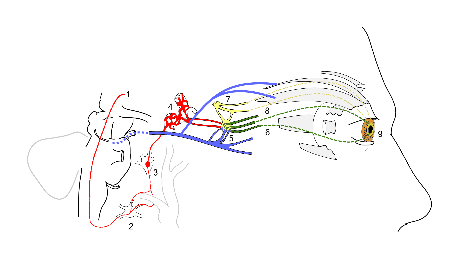|
Horner's syndrome
Horner's syndrome, also known as oculosympathetic paresis,[1] is a combination of symptoms that arises when a group of nerves known as the sympathetic trunk is damaged. The signs and symptoms occur on the same side (ipsilateral) as it is a lesion of the sympathetic trunk. It is characterized by miosis (a constricted pupil), partial ptosis (a weak, droopy eyelid), apparent anhidrosis (decreased sweating), with apparent enophthalmos (inset eyeball).[2] The nerves of the sympathetic trunk arise from the spinal cord in the chest, and from there ascend to the neck and face. The nerves are part of the sympathetic nervous system, a division of the autonomic (or involuntary) nervous system. Once the syndrome has been recognized, medical imaging and response to particular eye drops may be required to identify the location of the problem and the underlying cause.[3] Signs and symptomsSigns that are found in people with Horner's syndrome on the affected side of the face include the following:
Interruption of sympathetic pathways leads to several implications. It inactivates the dilator muscle and thereby produces miosis. It inactivates the superior tarsal muscle which produces ptosis. It reduces sweat secretion in the face. Patients may have apparent enophthalmos (affected eye looks to be slightly sunken in) but this is not always the case. The ptosis from inactivation of the superior tarsal muscle causes the eye to appear sunken in, but when actually measured, enophthalmos is not present. The phenomenon of enophthalmos is seen in Horner's syndrome in cats, rats, and dogs.[5] Sometimes there is flushing on the affected side of the face due to dilation of blood vessels under the skin. The pupil's light reflex is maintained as this is controlled via the parasympathetic nervous system.[citation needed] In children, Horner's syndrome sometimes leads to heterochromia, a difference in eye color between the two eyes.[3] This happens because a lack of sympathetic stimulation in childhood interferes with melanin pigmentation of the melanocytes in the superficial stroma of the iris.[citation needed] In veterinary medicine, signs can include partial closure of the third eyelid, or nictitating membrane.[citation needed] Causes Horner's syndrome is usually acquired as a result of disease, but may also be congenital (inborn, associated with heterochromatic iris) or iatrogenic (caused by medical treatment). In rare cases, Horner's syndrome may be the result of repeated, minor head trauma, such as being hit with a soccer ball. Although most causes are relatively benign, Horner's syndrome may reflect serious disease in the neck or chest (such as a Pancoast tumor (tumor in the apex of the lung) or thyrocervical venous dilatation).[citation needed] Causes can be divided according to the presence and location of anhidrosis:[citation needed]
PathophysiologyHorner syndrome is due to a deficiency of sympathetic activity. The site of lesion to the sympathetic outflow is on the ipsilateral side of the symptoms. The following are examples of conditions that cause the clinical appearance of Horner's syndrome:[7]
If patients have impaired sweating above the waist affecting only one side of the body, and they do not have clinically apparent Horner's syndrome, then their lesions are just below the stellate ganglion in the sympathetic chain.[citation needed] Diagnosis Three tests are useful in confirming the presence and severity of Horner syndrome:
It is important to distinguish the ptosis caused by Horner's syndrome from the ptosis caused by a lesion to the oculomotor nerve. In the former, the ptosis occurs with a constricted pupil (due to a loss of sympathetics to the eye), whereas in the latter, the ptosis occurs with a dilated pupil (due to a loss of innervation to the sphincter pupillae). In a clinical setting, these two ptoses are fairly easy to distinguish. In addition to the blown pupil in a CNIII (oculomotor nerve) lesion, this ptosis is much more severe, occasionally occluding the whole eye. The ptosis of Horner syndrome can be quite mild or barely noticeable (partial ptosis).[7] When anisocoria occurs and the examiner is unsure whether the abnormal pupil is the constricted or dilated one, if a one-sided ptosis is present then the abnormally sized pupil can be presumed to be on the side of the ptosis.[citation needed] HistoryThe syndrome is named after Johann Friedrich Horner, the Swiss ophthalmologist who first described the syndrome in 1869.[9][10] Several others had previously described cases, but "Horner's syndrome" is most prevalent. In France and Italy, Claude Bernard is also eponymized with the condition (Claude Bernard–Horner syndrome, abbreviated CBH[11]). In France, Francois Pourfour du Petit is also credited with describing this syndrome. ChildrenThe most common causes in young children are birth trauma and a type of cancer called neuroblastoma.[12] The cause of about a third of cases in children is unknown.[12] See alsoReferences
External links |
||||||||||||
Portal di Ensiklopedia Dunia
